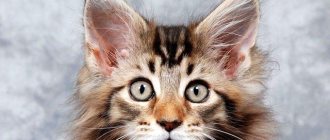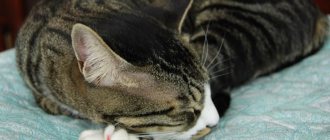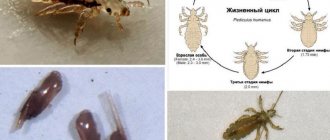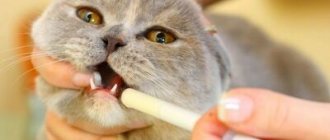A cat's ears can rightly be called its strongest and weakest point. It is well known that a cat's hearing is much more developed than a human's. Thanks to him, cats are able to track mice, even when they make virtually no sound, and escape from predators by recognizing their approach in advance. At home, the need for all these qualities disappears, but the load on the ears of pets remains just as significant. The slightest unfamiliar rustle is enough for a cat to wake up in the middle of the night. Owners often ignore such an important organ, believing that the pet will take care of its ears itself, and thereby make a serious mistake. We’ll talk further about how to clean a cat’s ears at home.
How to clean a cat's ears at home
Structural features
A cat's ears consist of three main sections:
- outer ear;
- average;
- internal.
This organ in such animals, as in most mammals, performs a dual function. Firstly, cats' ears are, of course, designed for hearing. This organ also allows animals to maintain balance and determine where is up and where is down.
Features of the procedure
There is an opinion that cotton swabs should not be used. This method is traumatic, so it is recommended to resort to an alternative option: you can also clean the ear from dirt and secretions with water, but you need to wash the baby carefully so as not to scare it.
Safety regulations
Before performing the procedure, you should learn how to properly clean your pet’s ears from dirt.
The following manipulations are performed:
- The animal is wrapped in a towel.
- The ear is carefully bent outward, and the curves of the inner part become clearly visible.
- A cotton pad is moistened in a special product.
- Carefully wipe the inside.
- If necessary, such actions are repeated, but with a clean disk.
- Moisten the cotton swab. Clean the bends from the inside to the outside, otherwise the dirt may push deeper, and this can lead to inflammation.
Owners are often afraid that the animal's eardrum may be damaged when performing such actions. But you shouldn’t be afraid of this: kittens have a bend in the ear canal that does not allow deeper cleaning of the ear.
There is a risk of damage to delicate skin, but this happens if hard sticks are used or the actions are performed carelessly.
Auricle
The outer part of the cat's hearing organ, in turn, consists of:
- cartilage;
- entrance to the external auditory canal.
Since the shell of such pets is cartilage, it stands vertically in most cases. On the outside, the outer part of the cat's hearing organ is covered with short hair. The inside of the shell of furry pets is smooth and devoid of hair.
Cats' ears are able to rotate in the direction of the sound source. This is also why cats have excellent hearing. The ears of these animals are located on both sides of the upper part of the head. At the same time, cats are capable of turning them in different directions.
Cleaning technique
Cats are taught hygiene procedures from early childhood. It is advisable to periodically pick up the kitten and touch its ears. Then you can carefully examine them.
When the baby begins to calmly perceive all the manipulations, they move on to the procedure itself.
For your information. Kittens can have their ears cleaned starting at 8 weeks.
A kitten's ears need to be cleaned in the same way as an adult cat. Veterinarians recommend developing the right approach to sanitation:
- Choose a moment when the cat is relaxed, not sleeping, not playing, not eating or licking itself.
- Place on your lap or any hard surface. Stroke and soothe.
- Secure the cat's head. Drop about 0.5 ml of lotion into the ear. The liquid should be warm. If it was in the refrigerator, you should first leave it in the room for a while.
- Gently, without applying too much pressure, massage the base of the ear for 30-60 seconds so that the liquid is evenly distributed. If you do everything correctly, you will hear a characteristic squelching sound.
- Release the cat. She will begin to shake her head, trying to get rid of the strange sensations in her ears.
- After this, take your pet in your arms and wipe the inside of the ear dry with a cotton pad or bandage, simultaneously removing wax and dirt. No need to go too deep. There is a high risk of causing pain and injury to the cat during the cleaning process.
- It is important that there is no moisture left inside. Subsequently, the liquid will not be able to evaporate from the tortuous ear canal and will lead to the development of inflammation, because it serves as a breeding ground for bacteria.
After the procedure, the cat is praised and treated to its favorite treat. If the animal is just being taught hygiene, cleaning can be divided into 2 stages: first treat one ear, and after a while the other.
Ear cleaning does not cause discomfort to pets. However, many of them do not like interference in their lives. During the cleaning process, the cat is gently spoken to and reassured so that it does not become nervous and is calm about such manipulations in the future. If the pet breaks out despite persuasion, you can swaddle it in a terry towel or put on a restraining overalls.
Important. Breeds such as the Elf and Dwelf require especially careful handling of their ears during cleaning. They have weak cartilage that is easily injured.
Until the animal learns to tolerate cleaning, it is better to ask someone for help. One person will hold the pet, and the other will carry out the treatment.
The owner must remain calm, even if the cat meows and tries to escape. Screaming or physical abuse will only make the situation worse. Then the pet will try by any means to avoid cleaning.
For your information. If the ear is very dirty, it is first washed with warm saline solution to soften the dirt, and then cleaned.
Anatomy of a cat's ear: structure of an acoustic tube
The opening of the auditory canal leading to the eardrum in such pets is located in the middle part of the base of the shell. The acoustic canal in cats is a cartilaginous hollow tube covered along its entire length with a leathery membrane. The latter, in turn, is capable of releasing sulfur. This substance is necessary for self-cleaning cats’ ears from foreign objects and dust.
In its lower part, the acoustic canal curves and connects with a hollow horizontal section ending in the eardrum. A special feature of the structure of cats' ears, among other things, is the high degree of protection of the acoustic membrane. There is no need to worry about damaging your pet's membrane when cleaning it, for example.
Rules for cleaning ticks
Ear mites live in the ear canal and feed on skin cells. It is impossible to see the parasite with the naked eye. Only the products of its vital activity are clearly visible (dirty dark brown flakes).
The symptoms of the lesion are as follows:
- restless behavior;
- the pet shakes its head, scratches its ear, scratches it until it bleeds;
- rubs his head against interior items;
- an unpleasant odor appears;
- the presence of dark crusts is noted;
- hearing problems arise.
Such changes cannot be ignored. Special means are used. The drug Bars is considered the most affordable.
The ear is treated as follows:
- The pet is wrapped in a towel and placed on your lap. He should be stroked and calmed down.
- The auricle is turned out. The kitten is securely restrained.
- Wipe the inner surface with a moistened cotton swab.
- Use a cotton swab to go along the curves, without bringing it into the ear canal.
After removing the plaque, they begin to get rid of the mites: take a cotton swab, moisten it in the product and gently wipe the ear canal (the swab is not inserted too deeply).
These actions are performed daily for 2 weeks. The medicine is instilled into the ear every 4 times. It is important that the kitten does not shake its head, otherwise the drug will spill out.
Middle ear
This part of the cat's hearing organ is located in the skull, in the temporal part. It is represented by three aurecal ossicles - the anvil, the malleus and the stirrup. Also part of a cat's middle ear are two muscles. The bones of these animals are connected to the snail. The middle ear of furry pets looks like a membranous tambourine. Vibrations from the membrane are transmitted to the bones and then enter the oval window of the cochlea.
The structure of cats' ears is such that they are able to capture vital sounds well. At the same time, too loud noise in the middle ear of such animals is muffled.
intimate ear
This part of the hearing organ in cats, like in other mammals, is a cochlea or labyrinth. The place of concentration of sound-receiving cells and various auxiliary structures is called the organ of Corti.
Sensory cells in cats are placed in liquid and protected on all sides by a filmy texture. Among other things, they have microscopic protrusions. It is the latter that perceive sound vibrations, and then transmit them to the receptors of the auditory nerves connected to the organ of Corti.
Any breed of cat has three microscopic semi-oval holes in the ear. These formations are filled with liquid and adjacent to each other at an angle. The main purpose of these holes is to balance and maintain balance for the animal. The vibrations of the liquid in them are captured by thin hairs and transmitted by them to the brain, which, in turn, records the position of the body in relation to the horizon.
What shape can ears have?
The external auditory organ in most cat breeds is small in size and placed vertically. But in some breeds of these domestic animals the shell has an unusual shape. For example, the structure of the ears of Scottish cats can be called very original. In such animals, the shells are directed forward and seem to hang over the head, fitting quite tightly to it.
There are also breeds with large ears, such as Sphynxes. Curl cats have shells that are completely turned outward. In addition to color, a cat’s ears and tail are what mainly determine its belonging to a particular breed. In any case, no matter what shape the shell of such a pet has, its hearing will be simply excellent. The internal structure of the ears of such pets is the same.
Features of eye care
The Sphynx's eyes do not have eyelashes, so they also require special care. Normally, a small amount of light brown discharge accumulates in the inner corners, which then dry out and turn into dark crusts. They should be removed as daily as possible.
Tonics are used for sphinx eye hygiene. They contain purified water, glycerin, salt, boric acid, and herbal extracts. For animals with sensitive skin, it is better to choose hypoallergenic lotions.
Such agents can be easily replaced with saline solution. In most cases, this is done, because Sphynx cats often suffer from allergies.
How to clean your pet's eyes?
Cleaning is done with a damp cotton pad or swab. First, wipe one eye, removing dirt from the outer corner to the inner one. Then take a clean sponge and treat the eyelids on the other side in the same way.
At the end of the procedure, you need to make sure that the lint from the cotton pad does not get on the mucous membrane of the eyes.
Important! It is recommended to use a composition whose temperature is close to 38-40 °C. A cold tonic will cause discomfort in the Sphinx.
So, sphinxes need to clean their ears every 7-10 days, and their eyes every day. In order for the cat to learn to respond normally to hygiene procedures, you need to treat him kindly, and after manipulations, always treat him with something tasty.
However, it is not advisable to clean too often, since sulfur serves to protect the hearing organs from infections.
Otitis in a cat: symptoms
The causes of this disease can be injury, ear mites, water getting into the ear, etc. Otitis media in cats manifests itself primarily as itching and excessive secretion of wax. In this case, the animal constantly shakes its head. If the disease is localized in the middle or inner ear, a purulent exudant also appears in the cat's shell.
Otitis media can also be diagnosed by:
- unpleasant odor from the ears;
- high body temperature.
The ears of a cat with otitis media are usually hot. There is also a high probability of suspecting this disease in a pet if it has previously been diagnosed with otodectosis.
Prevention and treatment of otodectosis in cats
Prevention of ear disease is based primarily on hygiene. In addition, to prevent infection with ear mites, it is necessary to protect your pets from contact with stray animals. Fleas can also be carriers of ticks, so you need to use parasite protection.
Hygienic cleaning of the ears is carried out with special lotions that not only clean the inside of the auricle, but also have disinfectant and anti-inflammatory properties.
Table: products used for preventive and hygienic cleaning of ears or as part of the treatment of ear diseases
| Name of lotion, manufacturer. | Appearance and composition. | Action of the drug. | Price. |
| Bars, Russian. | Transparent liquid, the components of which are:
| Removes earwax, dirt and inflammatory products. It also has an anti-inflammatory and anti-edematous effect. | Bottle 20 ml - from 113 rub. up to 167 rub. |
| Ear cleaning lotion from the domestic company Veda. | Natural composition, including a large number of medicinal herbs. | Antimicrobial, anti-inflammatory and regenerating effect. | Bottle - dropper 15 g - about 68 rubles. |
| Cliny, a lotion produced by Russian. | Components:
| Cleanses dirt and ear discharge, softens the skin, has a disinfecting, regenerating and soothing effect. | Bottle 50 ml - from 180 rub. and higher. |
| Aptus Orisolve, produced by a Finnish company | A transparent, slightly viscous liquid having the following composition:
| Removes dirt, earwax and other deposits, helps reduce inflammation, and has regenerating and antibacterial properties. | Bottle 150 ml - from 1120 rub. |
| Beaphar Ear Cleaner lotion from a Dutch manufacturer. | Contains:
| Cleanses dirt, earwax, has antiseptic and disinfectant properties | Bottle 50 mg - from 435 rub. |
When using lotion, a cotton pad or cotton swab is moistened and the inner surface of the ear is cleaned (the ear can be turned outward). It is necessary to carefully and thoroughly clean all bends and corners, replacing the cotton swab when it becomes dirty. If there is a lot of discharge, you can first drop a few drops, massage the ear at the base and begin cleaning after the dirt has softened. This procedure is not very pleasant for a cat, and during the inflammatory process it is also painful, so it is better to do it together.
Video: how to clean a cat's ears
Photo gallery: Ear cleaning lotions for cats
VEDA ear cleaning lotion is used for hygienic treatment of dogs, cats and other small pets
CLINY ear cleansing lotion is used for dogs, cats, kittens, puppies, rabbits and ferrets
Ear Cleaner is a preventative ear cleaner for dogs, cats and other small pets.
Drops for treatment
If your pet is sick with otodectosis or otitis, using one lotion may not be enough. It is necessary to use more effective means, which include ear drops. There is a large selection of these products on the domestic market, but it is advisable to decide on the choice in consultation with a veterinarian. Combination drugs are intended for the treatment of otitis of various etiologies, but in severe cases they must be combined with other drugs for complete recovery.
Table: drops used for ear diseases in cats
| A drug. | Appearance and composition. | Impact on the body. | Price. |
| French Aurican ear drops. | Colorless, not entirely transparent liquid. The active ingredients are:
Auxiliary:
| Combined drug for the prevention and treatment of otitis of any etiology and otodectosis. It has acaricidal, antibacterial, anti-inflammatory and anesthetic properties. | Bottle 20 ml - from 450 rub. up to 550 rub. |
| Ear drops Anandin plus St. Petersburg. | A transparent solution with a yellowish tint, contains the following active substances:
The following are used as auxiliary components:
| Intended for the treatment of otodectosis in domestic animals, it has acaracidal, antimicrobial and anti-inflammatory effects. | Bottle 5 ml. — from 60 rubles to 78 rubles. |
| Drops of Dekta Forte Moscow. | A transparent oily solution, the active ingredients of which are:
Auxiliary:
| Combined product to combat diseases caused by skin mites in domestic animals:
It has antibacterial and anesthetic properties, relieves itching. | Bottle 10 ml - from 118 rub. up to 128 rub. |
| Amitrazine drops from the Russian company Top-Vet. | An oily liquid, its active ingredient is amitraz (an insecticide to combat ticks), and the auxiliary components are rapeseed oil and dimethyl sulfoxide. | The drug has low toxicity, can be effective against ticks that are resistant to other drugs, and is characterized by anti-inflammatory, bactericidal and softening effects on the skin. | 10 ml bottle - from 63 rubles to 90 rubles. |
| Bars AVZ - ear mite drops for cats and dogs. | The active ingredient is diazinon, which is an insecticide for arthropods and mites. The following excipients are used: prednisolone and glycerin. They provide the antiseptic, anti-inflammatory and antipruritic properties of the drug. | Leopard is used for the treatment and prevention of otodectosis | Bottle 20 ml from 115 rubles to 165 rubles. |
| Ear drops Pchelodar Otidez, domestic. | Translucent liquid, the active ingredients of which are:
| A combined remedy intended for the treatment of bactericidal, fungal and parasitic otitis in acute and chronic form, and is also used to relieve an allergic reaction in the outer ear. | Bottle 15 ml from 180 rubles to 210 rubles. |
| Otovedin ear drops. | A light yellow solution containing organophosphorus compounds and Alpha Pinene salt. | Medicine against subcutaneous ticks in dogs and cats. Has antimicrobial and anti-inflammatory effects. | Bottle 10 ml from 43 rubles to 74 rubles. |
| Drops Surolan from the American company Eli Lilly and Company. | White oily suspension. The active substances are:
Auxiliary:
| A complex drug for the treatment of otitis of bacterial and fungal origin. Has anti-inflammatory and antiallergic properties. | Bottle 15 ml from 356 rubles to 675 rubles. |
| Ear drops Ektodes Russian. | A transparent solution of various shades of yellow. The active substances are sulfur, propolis, pyrethroid and dimexide. | A combined remedy against all types of subcutaneous mites that parasitize cats. It has anti-inflammatory, antimicrobial and regenerating properties, reduces the manifestation of allergic reactions. | Bottle 10 ml about 55 rub. |
According to the sales rating, the most popular drugs include the following:
- Aurikan;
- Anandin plus;
- Decta Forte;
- Leopard;
- Otovedin.
Treatment of otitis media
In order to alleviate the condition of a pet with this disease, it first needs to clean the sink of scabs and wax. For this purpose, it is best to use tampons soaked in your choice of:
- boric acid;
- peroxides;
- chlorhesidine;
- furatsilin;
- miramistine.
If there is a lot of pus in the cat’s ear or it is located deep, it would be better to take the animal to a veterinary clinic. The specialist will perform the procedure in this case, of course, with the highest quality possible.
To treat otitis media in cats, various types of drugs instilled into the ears can be used. A veterinarian should also prescribe such medications to an animal. The fact is that with otitis media, a cat's eardrum can become like a mesh. In this case, some types of drugs are contraindicated for furry pets.
Most often, the following types of drops are prescribed for instillation into the ears of cats for otitis media:
- "Otovedin."
- "Sofradex".
- "Aurican".
- "Tsipam."
- "Surolan".
For purulent otitis, such animals are also often prescribed antibiotics. These could be, for example, Erythromecin, Spiramycin, Cefazolin.
Cleaning a cat's ears - step-by-step instructions
- Position the cat so that it is positioned sideways to you and sit it on your lap. If necessary, grab it by the withers or wrap it in a towel;
- Carefully turn out the auricle and inspect its contents for the presence of dirt, inflammation and crusts;
- If you notice heavy discharge, take a swab and dip it in the chlorhexedine solution. Squeeze it out and walk along the inside of the ear, without pressing or going deep inside;
Gently lift the skin at the base to blot the surface of the ear with the swab
- If more wax has accumulated in your pet's ears, drop saline solution into the ear canal and massage it so that the liquid flows inside. After instillation, hold the cat for ten minutes to ensure that the solution has reached its target;
- If the solution used is in a bottle, then lower its tip two to three millimeters into the ear canal and squeeze out the required number of drops;
- When using cotton swabs, do not try to push them in as far as possible. In the inner ear, as a rule, wax does not accumulate due to the presence of the eardrum, therefore there is nothing special to clean “in depth”;
- When working with cotton swabs, make sure that your movements are directed outward and not inward, otherwise you will only push the sulfur deeper, from where it will be even more difficult to get it out;
Movements made with a cotton swab must be carried out according to strict rules
- When you are sure that the drops have successfully passed inside, wipe the animal's ears with a towel and reward him with a treat for his outstanding achievements.
Keep in mind that too frequent cleaning of your pet's ears leads to damage to the ear microflora, which is also fraught with various diseases. The frequency of cleanings depends on the breed and should be discussed with your veterinarian.
By the way! Hairless cats produce more earwax and require frequent cleaning.
Symptoms of ear dermatitis
This disease occurs quite often in cats. Ear dermatitis is a group of diseases characterized primarily by symptoms such as redness of the skin and rashes. The reasons for the development of this disease in cats can be, for example:
- parasites;
- allergy;
- injury;
- chemical or thermal burn.
Sometimes dermatitis occurs when an animal takes any medications uncontrolled. Any cat diseases should be treated in strict accordance with the veterinarian’s recommendations.
How to treat food dermatitis
It is as an allergic reaction to any food that this disease occurs most often in furry pets. The ears of both fold-eared cats and ordinary breeds can suffer from dermatitis. Unfortunately, no drugs have been developed that can cure food dermatitis in such animals once and for all. Owners of such a cat just need to carefully monitor what it eats and try to identify foods that cause a reaction. This is quite difficult to do, since quite a long time passes after eating and the first signs of allergic dermatitis. But with a little effort, you will most likely still be able to identify products that are unsuitable for your pet.
How to treat scabies
This disease is caused by mites that fall on the cat's skin through contact with other animals, birds, humans or any objects. To cure a pet, its shells must first be cleaned of scabs and dirt. The structure of a cat's ears is such that this procedure will be very easy.
At the next stage, the affected areas are lubricated with a special preparation. The type of product is chosen depending on the type of mite infesting the cat’s ears. For example, to treat scabies, drugs such as aversectin ointment 0.05%, creolin 3%, cydectin, etc. can be used.
To prevent the development of scabies, owners should limit their cat's contact primarily with stray cats. This is how the tick usually migrates from animal to animal. Owners of cat breeds with large ears should especially adhere to this recommendation. The area affected by such an animal can be very large, causing it to experience significant suffering.
Does a cat need ear cleaning?
Indoor cats do not need regular ear cleanings like dogs. And ear diseases are relatively less common among them than other animal species.
Under normal conditions, sulfur is secreted in small quantities. If you frequently clean your cat's ears, the secretion begins to be produced more strongly. And this leads to ear plugs and other problems. To maintain a healthy ear, it is enough to periodically clean the inside of the auricle and the beginning of the ear canal.
Exceptions are cats with a small amount of fur (hairless). In such animals, contamination occurs more quickly, so they need regular cleaning. The sparse hairs inside the ear cannot provide protection from dust and dirt, and the body compensates for this by increasing the production of wax.
This feature is typical for the following breeds:
- kohana;
- elf;
- sphinx;
- Peterbald;
- lefty
Rex, Maine Coon, Savannah, Somali, Oriental and Abyssinian cats have large ears, in which dust also quickly accumulates. It is recommended to clean it about once a week. However, due to individual characteristics, some representatives of these breeds may have ears that remain clean for a long time.
Excessive accumulation of sulfur leads to the proliferation of bacteria and fungi. The cat's immunity weakens, it loses the ability to resist parasitic diseases, and is often affected by ear mites.
Fold-eared cats cannot wash their ears on their own due to the structure of the auricle. Therefore, the owner must process them approximately once every 2 weeks. It is also not advisable to clean the ears of fold-eared cats excessively often. After all, without natural secretion, they are more likely to develop various diseases.
If your pet has too much wax and dirt in his ears, and they accumulate quickly after cleaning, you should take the animal to the veterinarian.
Perhaps the cat has some kind of disease. The specialist will prescribe appropriate medications. In this case, cleansing the auricle is only a concomitant procedure. And treatment is aimed at eliminating the cause.











